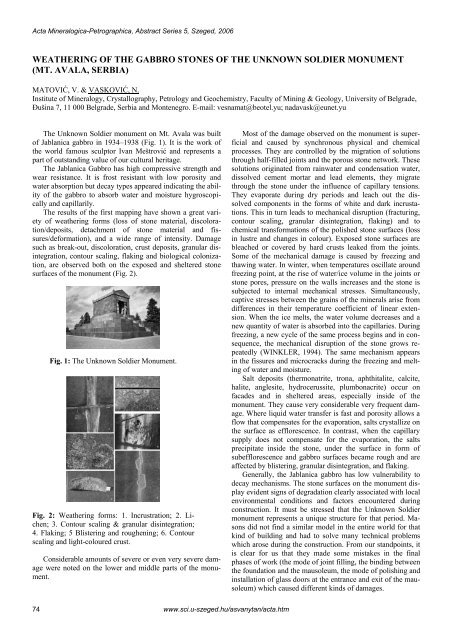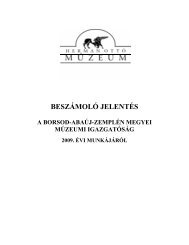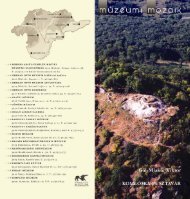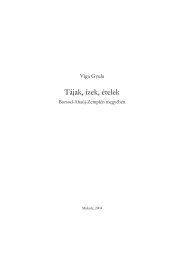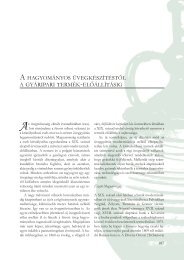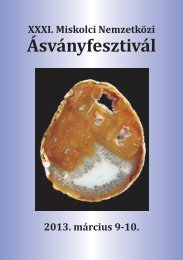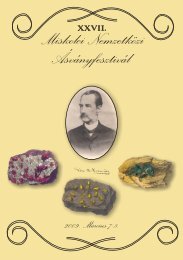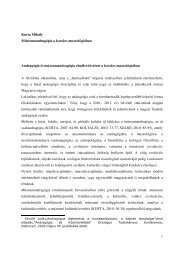Acta Mineralogica-Petrographica, Abstract Series 5, Szeged, 2006WEA<strong>THE</strong>R<strong>IN</strong>G OF <strong>THE</strong> GABBRO STONES OF <strong>THE</strong> UNKNOWN SOLDIER MONUMENT(MT. AVALA, SERBIA)MATOVIĆ, V. & VASKOVIĆ, N.Institute of Mineralogy, Crystallography, Petrology and Geochemistry, Faculty of Mining & Geology, University of Belgrade,Đušina 7, 11 000 Belgrade, Serbia and Montenegro. E-mail: vesnamat@beotel.yu; nadavask@eunet.yuThe Unknown Soldier monument on Mt. Avala was builtof Jablanica gabbro in 1934–1938 (Fig. 1). It is the work ofthe world famous sculptor Ivan Meštrović and represents apart of outstanding value of our cultural heritage.The Jablanica Gabbro has high compressive strength andwear resistance. It is frost resistant with low porosity andwater absorption but decay types appeared indicating the abilityof the gabbro to absorb water and moisture hygroscopicallyand capillarily.The results of the first mapping have shown a great varietyof weathering forms (loss of stone material, discoloration/deposits,detachment of stone material and fissures/deformation),and a wide range of intensity. Damagesuch as break-out, discoloration, crust deposits, granular disintegration,contour scaling, flaking and biological colonization,are observed both on the exposed and sheltered stonesurfaces of the monument (Fig. 2).Fig. 1: The Unknown Soldier Monument.Fig. 2: Weathering forms: 1. Incrustration; 2. Lichen;3. Contour scaling & granular disintegration;4. Flaking; 5 Blistering and roughening; 6. Contourscaling and light-coloured crust.Considerable amounts of severe or even very severe damagewere noted on the lower and middle parts of the monument.Most of the damage observed on the monument is superficialand caused by synchronous physical and chemicalprocesses. They are controlled by the migration of solutionsthrough half-filled joints and the porous stone network. Thesesolutions originated from rainwater and condensation water,dissolved cement mortar and lead elements, they migratethrough the stone under the influence of capillary tensions.They evaporate during dry periods and leach out the dissolvedcomponents in the forms of white and dark incrustations.This in turn leads to mechanical disruption (fracturing,contour scaling, granular disintegration, flaking) and tochemical transformations of the polished stone surfaces (lossin lustre and changes in colour). Exposed stone surfaces arebleached or covered by hard crusts leaked from the joints.Some of the mechanical damage is caused by freezing andthawing water. In winter, when temperatures oscillate aroundfreezing point, at the rise of water/ice volume in the joints orstone pores, pressure on the walls increases and the stone issubjected to internal mechanical stresses. Simultaneously,captive stresses between the grains of the minerals arise fromdifferences in their temperature coefficient of linear extension.When the ice melts, the water volume decreases and anew quantity of water is absorbed into the capillaries. Duringfreezing, a new cycle of the same process begins and in consequence,the mechanical disruption of the stone grows repeatedly(W<strong>IN</strong>KLER, 1994). The same mechanism appearsin the fissures and microcracks during the freezing and meltingof water and moisture.Salt deposits (thermonatrite, trona, aphthitalite, calcite,halite, anglesite, hydrocerussite, plumbonacrite) occur onfacades and in sheltered areas, especially inside of themonument. They cause very considerable very frequent damage.Where liquid water transfer is fast and porosity allows aflow that compensates for the evaporation, salts crystallize onthe surface as efflorescence. In contrast, when the capillarysupply does not compensate for the evaporation, the saltsprecipitate inside the stone, under the surface in form ofsubefflorescence and gabbro surfaces became rough and areaffected by blistering, granular disintegration, and flaking.Generally, the Jablanica gabbro has low vulnerability todecay mechanisms. The stone surfaces on the monument displayevident signs of degradation clearly associated with localenvironmental conditions and factors encountered duringconstruction. It must be stressed that the Unknown Soldiermonument represents a unique structure for that period. Masonsdid not find a similar model in the entire world for thatkind of building and had to solve many technical problemswhich arose during the construction. From our standpoints, itis clear for us that they made some mistakes in the finalphases of work (the mode of joint filling, the binding betweenthe foundation and the mausoleum, the mode of polishing andinstallation of glass doors at the entrance and exit of the mausoleum)which caused different kinds of damages.74www.sci.u-szeged.hu/asvanytan/acta.htm
Acta Mineralogica-Petrographica, Abstract Series 5, Szeged, 2006MICRO<strong>M<strong>IN</strong>ERAL</strong>OGY OF IGNIMBRITES OF SOKYRNYTSYA ZEOLITE DEPOSIT(TRANSCARPATIANS, UKRA<strong>IN</strong>E)MELNIKOV, V. S. 1 , GRECHANOVSKAYA, E. E. 1 , DEMENKO, D. P. 2 , KVASNYTSYA, V. N. 1 & LAZARENKO, E. E. 31 Institute of Geochemistry, Mineralogy and Ore Formation of NAS Ukraine, Palladine av. 34, Kyiv, UkraineE-mail: vsmel@i.com.ua2 Institute of Geological Sciences of NAS Ukraine, Gonchara str. 55-b, Kyiv, Ukraine3 Institute of Geochemistry Environment of NAS of Ukraine, Palladine av. 34-a, Kyiv, UkraineIgnimbrites stretching under clinoptilolite tuffs of the Sokyrnytsyadeposit belong to the Teresvinskaya suite (UpperTortonian). These ignimbrites consist of a) splinters of volcanicglass, b) magmatogenic minerals (fragments of crystalsand entire, non-destructed crystals); c) newly formed minerals.In some areas felsitic texture changed into vitroclasticand crystalloclastic ones on the scale of a thin section. Theshape of the glass splinters is formed by spherical surfaces ofdestroyed (blown up) gas bubbles. The indications of ignimbritesare as follows: a) crystals of magmatic feldspars andquartz are broken and cemented by rock of felsitic texture; b)highly deformed crystals of biotite; c) fragments of crystalare shifted and rotated in the plastic felsitic medium.Phenocrysts of magmatic minerals are plagioclase (oligoclase–andesine#28–32 and andesine #40), quartz, sanidineand biotite. Apatite, zircon, magnetite are accessory minerals.Plagioclase, K-feldspar, quartz, cristobalite (?), mafic andopaque minerals and glass constitute microfelsitic groundmass.The main new mineral formations are adularia, albiteand calcite. Muscovite, analcime and acicular zeolites occursporadically. A cryptocrystalline bluish-green mica(polytypes 1M and 1M d ) is a characteristic mineral of ignimbrites.This mica may be an alteration product of pumiceinclusions.Large idiomorphic crystals of quartz with hightemperaturehabit are not often observed but fragments of thisquartz prevail in the rock. The later quartz forms accretionsof prismatic crystals on the faces of adularia.Idiomorphic transparent crystals of plagioclase can reach1-2 mm in size but they occur only occasionally. Zoned crystalsare rarely observed. Twins according to the albite law arepredominant but crystals are often untwinned or the twins arebuilt up by a few wide domains only. Plagioclase (oligoclase–andesine)is the main clastic material of ignimbrite.Phenocryts of sanidine are seldom, but crystal fragmentsare common. In rare cases anisotropic strips similar to “tweedorthoclase” are observed.The main femic mineral of ignimbrites is mosaic-texturedbiotite (0.1–2.0 mm). Small crystals are concentrated in thefelsite. They are strongly deformed (curved, folded, split).Adularia is widespread postmagmatic mineral of thewelded tuffs of Sokyrnytsya deposit. It forms small (less than0.05 mm) crystals substituting the fragments of volcanicglass. Adularia growing in the pores of the rock creates finemicrodruses. Its crystal forms according to SEM studies are{110}, {001}, {–201}, {100}. Adularia crystallized on theboundary of glass and felsite and a complete substituting ofglass can be observed sometimes. An interesting peculiarityof adularia from the Sokyrnytsya ignimbrite is the low degreeof Si/Al-ordering in the structure (2t 1 = 0,58–0,62); it is comparablewith the degree of Si/Al-ordering in sanidine. Calciteforms aggregates of grains, which recrystallized into largemosaic crystals.Melt inclusions are always present in magmatic minerals(plagioclase, quartz). Every inclusion have rectilinear shapeand they are oriented along crystallographic axes. Homogeneousglass inclusions prevail. Gas bubbles in glass inclusionscan be observed very seldom, however the gas may behidden among recrystallized grains. So these inclusions reflectdifferent degree of gas saturation of magmatic melt.Inclusions in adularia have never been observed.Formation of adularia of ignimbrites is connected to theinfluence of hot mineralizing solutions on rhyolite-daciteglass. The heat source was the large mass of hot ignimbrite.Vertical loading and transfer of plastic ash materials (incompletelyconsolidated fallen aerosol) caused opening of the gasmicrobubbles and saturation of the solution by CO 2 . Adulariacrystallized as a metastable phase immediately from volcanicglass. It is suggested that the low degree of Si/Al-ordering inthe structure of adularia was inherited from the amorphousglass.www.sci.u-szeged.hu/asvanytan/acta.htm 75
- Page 1:
MSCC33 rd MINERAL SCIENCES IN THE C
- Page 5 and 6:
Acta Mineralogica-Petrographica, Ab
- Page 7 and 8:
Acta Mineralogica-Petrographica, Ab
- Page 9 and 10:
Acta Mineralogica-Petrographica, Ab
- Page 11 and 12:
Acta Mineralogica-Petrographica, Ab
- Page 13 and 14:
Acta Mineralogica-Petrographica, Ab
- Page 15 and 16:
Acta Mineralogica-Petrographica, Ab
- Page 17 and 18:
Acta Mineralogica-Petrographica, Ab
- Page 19 and 20:
Acta Mineralogica-Petrographica, Ab
- Page 21 and 22:
Acta Mineralogica-Petrographica, Ab
- Page 23 and 24: Acta Mineralogica-Petrographica, Ab
- Page 25 and 26: Acta Mineralogica-Petrographica, Ab
- Page 27 and 28: Acta Mineralogica-Petrographica, Ab
- Page 29 and 30: Acta Mineralogica-Petrographica, Ab
- Page 31 and 32: Acta Mineralogica-Petrographica, Ab
- Page 33 and 34: Acta Mineralogica-Petrographica, Ab
- Page 35 and 36: Acta Mineralogica-Petrographica, Ab
- Page 37 and 38: Acta Mineralogica-Petrographica, Ab
- Page 39 and 40: Acta Mineralogica-Petrographica, Ab
- Page 41 and 42: Acta Mineralogica-Petrographica, Ab
- Page 43 and 44: Acta Mineralogica-Petrographica, Ab
- Page 45 and 46: Acta Mineralogica-Petrographica, Ab
- Page 47 and 48: Acta Mineralogica-Petrographica, Ab
- Page 49 and 50: Acta Mineralogica-Petrographica, Ab
- Page 51 and 52: Acta Mineralogica-Petrographica, Ab
- Page 53 and 54: Acta Mineralogica-Petrographica, Ab
- Page 55 and 56: Acta Mineralogica-Petrographica, Ab
- Page 57 and 58: Acta Mineralogica-Petrographica, Ab
- Page 59 and 60: Acta Mineralogica-Petrographica, Ab
- Page 61 and 62: Acta Mineralogica-Petrographica, Ab
- Page 63 and 64: Acta Mineralogica-Petrographica, Ab
- Page 65 and 66: Acta Mineralogica-Petrographica, Ab
- Page 67 and 68: Acta Mineralogica-Petrographica, Ab
- Page 69 and 70: Acta Mineralogica-Petrographica, Ab
- Page 71 and 72: Acta Mineralogica-Petrographica, Ab
- Page 73: Acta Mineralogica-Petrographica, Ab
- Page 77 and 78: Acta Mineralogica-Petrographica, Ab
- Page 79 and 80: Acta Mineralogica-Petrographica, Ab
- Page 81 and 82: Acta Mineralogica-Petrographica, Ab
- Page 83 and 84: Acta Mineralogica-Petrographica, Ab
- Page 85 and 86: Acta Mineralogica-Petrographica, Ab
- Page 87 and 88: Acta Mineralogica-Petrographica, Ab
- Page 89 and 90: Acta Mineralogica-Petrographica, Ab
- Page 91 and 92: Acta Mineralogica-Petrographica, Ab
- Page 93 and 94: Acta Mineralogica-Petrographica, Ab
- Page 95 and 96: Acta Mineralogica-Petrographica, Ab
- Page 97 and 98: Acta Mineralogica-Petrographica, Ab
- Page 99 and 100: Acta Mineralogica-Petrographica, Ab
- Page 101 and 102: Acta Mineralogica-Petrographica, Ab
- Page 103 and 104: Acta Mineralogica-Petrographica, Ab
- Page 105 and 106: Acta Mineralogica-Petrographica, Ab
- Page 107 and 108: Acta Mineralogica-Petrographica, Ab
- Page 109 and 110: Acta Mineralogica-Petrographica, Ab
- Page 111 and 112: Acta Mineralogica-Petrographica, Ab
- Page 113 and 114: Acta Mineralogica-Petrographica, Ab
- Page 115 and 116: Acta Mineralogica-Petrographica, Ab
- Page 117 and 118: Acta Mineralogica-Petrographica, Ab
- Page 119 and 120: Acta Mineralogica-Petrographica, Ab
- Page 121 and 122: Acta Mineralogica-Petrographica, Ab
- Page 123 and 124: Acta Mineralogica-Petrographica, Ab
- Page 125 and 126:
Acta Mineralogica-Petrographica, Ab
- Page 127 and 128:
Acta Mineralogica-Petrographica, Ab
- Page 129 and 130:
Acta Mineralogica-Petrographica, Ab
- Page 131 and 132:
Acta Mineralogica-Petrographica, Ab
- Page 133 and 134:
Acta Mineralogica-Petrographica, Ab


